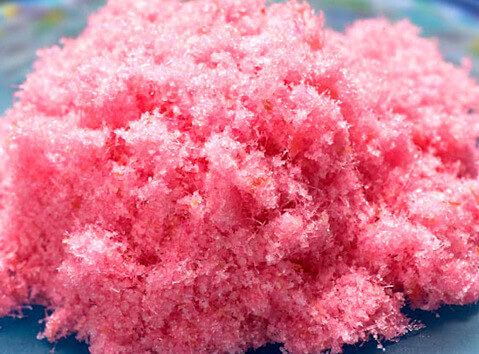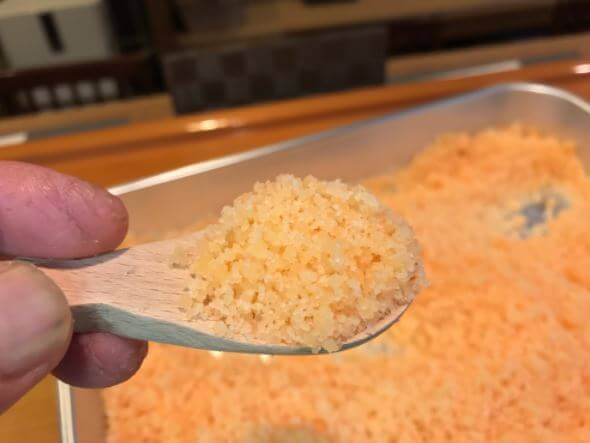
Oboro and Denbu are traditional Japanese ingredients often used in sushi and other dishes, known for their delicate texture and sweet flavor. While they may look similar and share many ingredients, understanding their subtle differences and uses can enrich your appreciation of Japanese cuisine.
Oboro and Denbu look the same, and the ingredients are also pretty much the same. In other words, there are no clear differences between them, but what it is called differs depending on the restaurant’s policy and the locality. There are various theories for this, but there is no clear line distinguishing oboro and denbu.
 Denbu (田麩) is mainly boiled white fish that is then loosened and made into fibers, then seasoned with sugar, mirin, salt, etc., then roasted until the moisture is gone. The most commonly used fish for denbu are Tara (Cod) and Tai (Red seabream), which have a mild flavor and light color suitable for this preparation. Some are colored with red food coloring (called sakura denbu) while others are left as the brown color similar to tsukudani. The appearance is as if only the fibers of the original ingredients remain. This is why it was written with the kanji “田夫” (the literal meaning of kanji: rice patty+husband). The word “田夫” means “someone from the countryside” or “rough-cut” and refers to the way the fish is turned into a coarse form by pulling the meat apart. It is also used as a coloring for chirashizushi, futomaki (large sushi rolls), bento boxes, etc. Because of its bright color and sweet flavor, denbu is often used to add visual and taste appeal to children’s meals and festive dishes in Japan.
Denbu (田麩) is mainly boiled white fish that is then loosened and made into fibers, then seasoned with sugar, mirin, salt, etc., then roasted until the moisture is gone. The most commonly used fish for denbu are Tara (Cod) and Tai (Red seabream), which have a mild flavor and light color suitable for this preparation. Some are colored with red food coloring (called sakura denbu) while others are left as the brown color similar to tsukudani. The appearance is as if only the fibers of the original ingredients remain. This is why it was written with the kanji “田夫” (the literal meaning of kanji: rice patty+husband). The word “田夫” means “someone from the countryside” or “rough-cut” and refers to the way the fish is turned into a coarse form by pulling the meat apart. It is also used as a coloring for chirashizushi, futomaki (large sushi rolls), bento boxes, etc. Because of its bright color and sweet flavor, denbu is often used to add visual and taste appeal to children’s meals and festive dishes in Japan.
 On the other hand, Oboro (朧) is made by using a grinding bowl to break down the meat of shiba shrimp or white fish, then seasoning with sugar, mirin and salt before removing the moisture over low heat. Oboro is used for bara-chirashi, futomaki (large sushi rolls), etc., and is also sometimes used between the topping and shari (vinegared rice) in nigiri sushi. This practice enhances the subtle flavor of the fish, serving as a base layer of umami, while helping the sushi topping blend more harmoniously with the vinegared rice. Oboro acts as a kind of “glue” between the neta (sushi topping) and the shari (vinegared rice), and it also adds a soft visual accent to the overall presentation. This gentle sweetness and the shrimp aroma are essential for Edomae-style sushi. Making oboro is laborious work, so there are fewer and fewer Edomae-style sushi restaurants that make their own oboro.
On the other hand, Oboro (朧) is made by using a grinding bowl to break down the meat of shiba shrimp or white fish, then seasoning with sugar, mirin and salt before removing the moisture over low heat. Oboro is used for bara-chirashi, futomaki (large sushi rolls), etc., and is also sometimes used between the topping and shari (vinegared rice) in nigiri sushi. This practice enhances the subtle flavor of the fish, serving as a base layer of umami, while helping the sushi topping blend more harmoniously with the vinegared rice. Oboro acts as a kind of “glue” between the neta (sushi topping) and the shari (vinegared rice), and it also adds a soft visual accent to the overall presentation. This gentle sweetness and the shrimp aroma are essential for Edomae-style sushi. Making oboro is laborious work, so there are fewer and fewer Edomae-style sushi restaurants that make their own oboro.
Although the distinction between Oboro and Denbu can be subtle and varies by region and restaurant, both play an important role in enhancing the flavor, texture, and appearance of Japanese dishes. Next time you enjoy sushi or chirashizushi, paying attention to these ingredients can deepen your culinary experience.
We hope this information will be helpful.

Revision date: August 5, 2025
Share this article